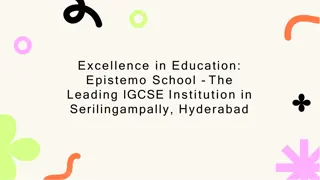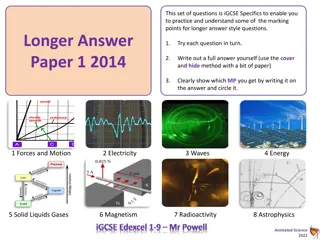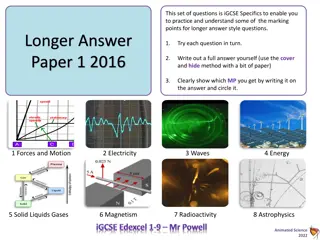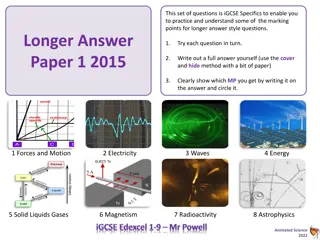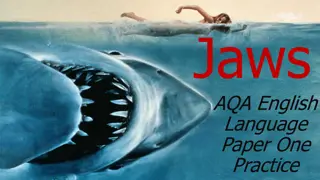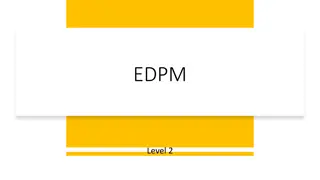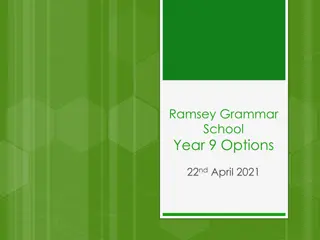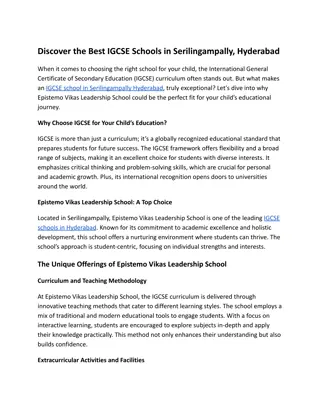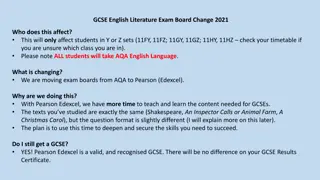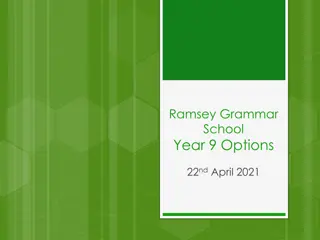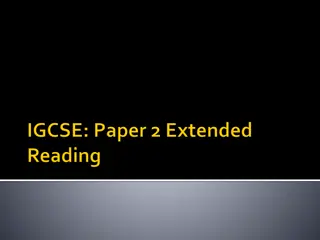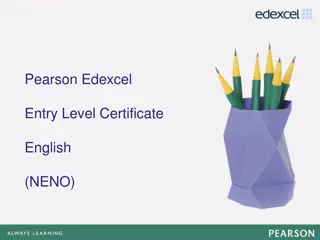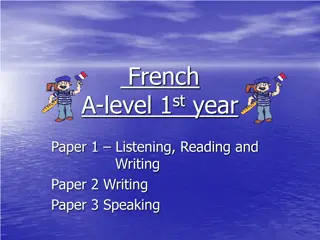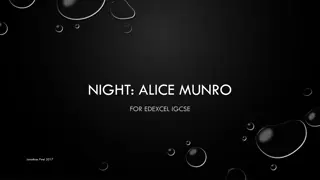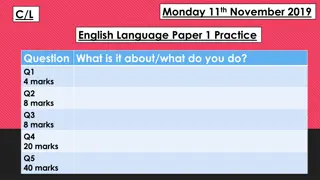Edexcel IGCSE First Language English Paper 1 Overview
Paper 1 of Edexcel's IGCSE First Language English assesses reading and writing skills. The examination consists of a reading section and a writing section. In the reading section, students engage with various texts and answer comprehension questions. The writing section offers different tasks like narrative writing, letter writing, etc., requiring students to effectively communicate. Specific tips are provided for approaching questions and analyzing passages to extract meaning and techniques used by the author to create intrigue.
Download Presentation

Please find below an Image/Link to download the presentation.
The content on the website is provided AS IS for your information and personal use only. It may not be sold, licensed, or shared on other websites without obtaining consent from the author. Download presentation by click this link. If you encounter any issues during the download, it is possible that the publisher has removed the file from their server.
E N D
Presentation Transcript
EDEXCEL ENGLISH 1st Langauge Paper 1
Paper 1 of Edexcel's IGCSE First Language English typically assesses reading and writing skills. The examination lasts for 2 hours and has a total of 80 marks available. Reading Section (approximately 45 minutes): This section typically consists of a series of texts, such as fiction, non-fiction, poetry, or visual texts. Students are required to read the provided texts carefully and answer a variety of comprehension questions. These questions may test skills such as identifying main ideas, understanding explicit and implicit information, analyzing language and style, and making inferences. Questions may vary in format, including multiple-choice, short-answer, and extended-response questions. Writing Section (approximately 1 hour and 15 minutes): The writing section usually presents students with a choice of writing tasks, such as narrative writing, descriptive writing, letter writing, or writing to argue or persuade. Students are required to select one or more tasks and write a response that demonstrates their ability to communicate effectively for different purposes and audiences. Tasks may include prompts or stimuli to inspire ideas and may require students to demonstrate skills such as creativity, coherence, organization, and accurate language use. The length and format of the writing tasks may vary, but students are typically expected to produce well- developed responses that meet the requirements of the task.
Q 1 -2 Reading comprehension and inference Q 1 What will I need to do? Locate a specific piece of information, such as a word or phrase, from the text. Q 2 What will I need to do? Locate two pieces of information in the text. There may be more than two available, and the information may be surface meaning (such as a fact) or implied meaning (such as a suggestion or hint). You can use specific quotations from the text or your own words, or both.
Q 3 reminder Top tips: Make sure you refer to both language and structure in your answer you can t get high marks if you don t reference both. Use the line references to get to the appropriate piece of text quickly. Highlight on the text words or phrases you think you may use in your answer. Remember to use short, precise quotations from the text. It s not enough to just identify the techniques being used you must explain how they are effective.
Q 3 analysis example 1 Read the following passage carefully. Then answer the question that follows. Passage: "The old house stood at the end of the lane, its weathered fa ade bearing the scars of time. Ivy tendrils crept up its walls, weaving intricate patterns that seemed to whisper secrets of centuries past. The windows, though once grand, now gazed out with a melancholic air, as if mourning the memories they held within. To the casual observer, it was just a dilapidated building, but to Emily, it was a treasure trove of stories waiting to be uncovered." Question 3: How does the author use language to create a sense of mystery and intrigue in the passage?
Q 3 analysis example 1 Model Answer: In the passage, the author adeptly employs various linguistic techniques to evoke a sense of mystery and intrigue, drawing the reader into the enigmatic atmosphere surrounding the old house. Firstly, the author utilizes vivid imagery to paint a picture of the setting, describing the house as having a "weathered fa ade" and "scars of time," suggesting a rich history shrouded in mystery. The use of the word "ivy tendrils crept up its walls" conjures up an image of nature reclaiming the structure, hinting at the passage of time and the gradual erosion of human presence, adding to the sense of intrigue. Furthermore, the author employs personification to imbue the house with a sense of life and consciousness, as seen in the description of the windows "gazing out with a melancholic air" and seemingly "mourning the memories they held within." This anthropomorphism lends an eerie quality to the house, suggesting that it harbors secrets and stories waiting to be discovered. Additionally, the choice of language throughout the passage, such as "whisper secrets," "centuries past," and "treasure trove of stories," conveys a sense of mystery and anticipation, inviting the reader to delve deeper into the narrative and uncover the hidden truths concealed within the old house. Overall, through the skillful use of imagery, personification, and evocative language, the author creates a palpable sense of mystery and intrigue, compelling the reader to immerse themselves in the enigmatic world of the old house and its untold stories.
Q 3 analysis example 2 Read the following passage carefully. Then answer the question that follows. Passage: "The moon hung low in the sky, casting a silvery glow over the deserted streets below. Shadows danced on the walls, their shapes twisting and turning with each flicker of light. A lone figure moved through the darkness, its footsteps echoing against the cobblestones. There was an air of mystery surrounding the night, as if secrets lurked in every corner, waiting to be discovered." Question 3: How does the author use language to create a sense of mystery and anticipation in the passage?
Q 3 analysis example 2 Model Answer: In this passage, the author skillfully employs language to cultivate an atmosphere of mystery and anticipation, drawing the reader into the enigmatic world of the deserted streets at night. Primarily, the author utilizes vivid imagery to evoke a sense of the eerie and the unknown. Phrases such as "shadows danced on the walls" and "twisting and turning with each flicker of light" conjure images of movement and uncertainty, setting the stage for the unfolding mystery. The description of the moon casting a "silvery glow" adds to the ethereal ambiance, hinting at hidden truths waiting to be revealed under the cover of darkness. Moreover, the use of personification imbues the setting with a sense of life and consciousness, as seen in the portrayal of the shadows "dancing" and the footsteps "echoing against the cobblestones." This anthropomorphic language lends an otherworldly quality to the scene, suggesting that the night itself is a character in the narrative, withholding its secrets from the lone figure traversing its streets. Additionally, the author employs sensory language to engage the reader's imagination and evoke a feeling of suspense. The mention of the "air of mystery" and the implication that "secrets lurked in every corner" creates a sense of anticipation, compelling the reader to immerse themselves in the unknown and uncover the hidden truths concealed within the darkness. Overall, through the adept use of imagery, personification, and sensory language, the author creates a palpable sense of mystery and anticipation, inviting the reader to explore the enigmatic world of the deserted streets at night and unravel the secrets that lie hidden within.
Q 3 analysis example 3 Passage: "The forest was a realm of shadows and whispers, where ancient trees loomed like sentinels guarding secrets buried deep within their roots. Shafts of sunlight pierced the dense canopy, casting dappled patterns on the forest floor. Every rustle of leaves, every crack of a twig, seemed to echo with the weight of untold stories. It was a place where time stood still, and the boundaries between reality and fantasy blurred into one." Question 3: How does the author use language to evoke a sense of mystery and enchantment in the passage?
Q 3 analysis example 3 Model Answer: In this evocative passage, the author masterfully employs language to weave a sense of mystery and enchantment, immersing the reader in the captivating world of the forest. Firstly, the author utilizes rich imagery to paint a vivid picture of the forest, describing it as a "realm of shadows and whispers" where "ancient trees loomed like sentinels." This imagery evokes a sense of awe and intrigue, conjuring images of a mystical landscape steeped in history and secrets waiting to be uncovered. Furthermore, the use of sensory language enhances the reader's immersion in the scene, with phrases such as "shafts of sunlight pierced the dense canopy" and "every rustle of leaves, every crack of a twig," creating a palpable atmosphere of tension and anticipation. These sensory details draw the reader deeper into the forest's embrace, heightening the sense of mystery and enchantment. Additionally, the author employs personification to imbue the natural elements with a sense of agency and significance. The portrayal of the trees as "sentinels guarding secrets buried deep within their roots" suggests a deeper, hidden purpose to the forest, adding to its mystique and allure. Moreover, the author's choice of language, such as "time stood still" and "the boundaries between reality and fantasy blurred into one," underscores the ethereal and otherworldly nature of the forest, inviting the reader to suspend disbelief and lose themselves in its enchanting depths. Overall, through the adept use of imagery, sensory language, and personification, the author creates a captivating atmosphere of mystery and enchantment, transporting the reader to a world where the natural and the supernatural converge, and the allure of the unknown beckons at every turn.
Q4 Readers effects What will I need to do? Evaluate how successful the writer has been throughout the entire text. This will involve referring to language and structural devices the writer uses, but you will also need to show how the writer builds an effect over the course of the piece. Your answer will need to have an overview of the text supplied, as well as an understanding of specific details. You will need to use quotations in your answer.
Q4 Readers effects Example 1 Passage: "The sun dipped below the horizon, casting the sky in hues of orange and pink. As twilight descended, the city came alive with the buzz of activity. Street vendors peddled their wares, their voices mingling with the laughter of children playing in the park. Couples strolled hand in hand along the riverbank, while the distant sound of music filled the air. It was a scene of bustling energy and vibrant life, capturing the essence of the city at dusk." Question 4: How does the author use language to create a vivid sense of atmosphere in the passage?
Q4 Readers effects Example 1 Model Answer: In this atmospheric passage, the author adeptly employs language to vividly depict the bustling energy and vibrant life of the city at dusk, transporting the reader into the heart of the scene. Primarily, the author utilizes vivid sensory imagery to evoke the sights, sounds, and sensations of the setting. Phrases such as "hues of orange and pink," "the buzz of activity," and "the laughter of children playing in the park" paint a rich and immersive picture of the bustling cityscape, allowing the reader to visualize the scene unfolding before them. Furthermore, the author's choice of descriptive language imbues the passage with a sense of movement and vitality. The portrayal of street vendors "peddling their wares" and couples "strolling hand in hand along the riverbank" conveys a dynamic sense of activity and interaction, capturing the rhythm and flow of life in the city at dusk. Additionally, the author employs auditory imagery to enhance the atmosphere, with phrases such as "the distant sound of music filled the air" evoking the auditory tapestry of the urban landscape. This auditory dimension adds depth and realism to the scene, immersing the reader in the sensory experience of the bustling city streets. Moreover, the author's use of figurative language, such as "twilight descended" and "capturing the essence of the city at dusk," imbues the passage with a poetic quality, elevating the description beyond mere observation to evoke a sense of mood and atmosphere. Overall, through the skillful use of sensory imagery, descriptive language, and figurative expression, the author creates a vivid and evocative portrayal of the city at dusk, capturing the essence of its bustling energy and vibrant life in exquisite detail.
Q4 Readers effects Example 2 Passage: "The ancient castle stood atop the cliff, its towering spires piercing the sky. Moss- covered stones whispered tales of bygone eras, while ivy-clad walls embraced centuries of history. Within its hallowed halls, shadows danced to the rhythm of time, echoing the footsteps of those who had walked before. The air was heavy with the weight of centuries, as if the very stones held secrets untold." Question 4: How does the author use language to convey a sense of history and mystery in the passage?
Q4 Readers effects Example 2 Model Answer: In this evocative passage, the author employs language to skillfully convey a sense of history and mystery, transporting the reader to the ancient castle perched atop the cliff. Primarily, the author utilizes vivid imagery to evoke the atmosphere of the setting. Phrases such as "towering spires piercing the sky," "moss- covered stones," and "ivy-clad walls" paint a rich and detailed picture of the castle, imbuing it with a sense of grandeur and antiquity. These descriptive details evoke the passage of time and hint at the castle's storied past, setting the stage for the unfolding mystery. Furthermore, the author's choice of language imbues the passage with a sense of atmosphere and mood. The mention of "shadows dancing to the rhythm of time" and the air being "heavy with the weight of centuries" evoke a palpable sense of history and mystery, suggesting that the castle is steeped in secrets waiting to be uncovered. This use of figurative language adds depth and complexity to the description, heightening the reader's curiosity and anticipation. Additionally, the author employs personification to animate the castle and imbue it with a sense of life and consciousness. The portrayal of "moss-covered stones whispering tales" and "shadows echoing footsteps" personifies the elements of the castle, suggesting that they hold secrets and memories of the past. This anthropomorphic language adds an eerie quality to the passage, enhancing its mysterious allure. Overall, through the skillful use of imagery, descriptive language, and personification, the author creates a vivid and atmospheric portrayal of the ancient castle, conveying a sense of history and mystery that captivates the reader's imagination and invites them to explore the secrets hidden within its walls.
Q 5-6 transactional writing What will I need to do? Choose one of two possible tasks. These will both require you to write an engaging, imaginative fiction piece which could be based on your real experiences or entirely made up. It should be appropriate to the purpose, audience and form stated in the task. One of the tasks will include two images you have the option of using one as a stimulus for your piece but you do not have to do this.





